Cabbage bhaji recipe with step by step photos – This cabbage bhaji or sabzi is a simple home style sauteed and steamed cabbage dish made with minimal ingredients. A vegan recipe that goes well with roti or paratha and makes for an excellent side dish with sambar rice or dal rice combo.
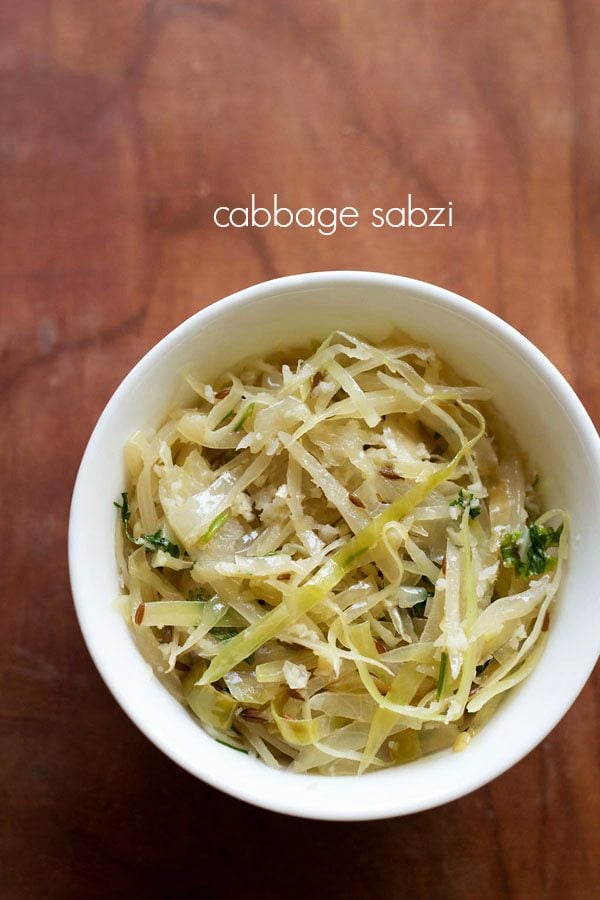
Coconut is added to the bhaji, which makes the overall dish have a faint sweet taste. The subtle sweetness of the cabbage also adds on to the overall flavor in this dish. Green chilies are added to give a bit of heat.
This is a no onion no garlic recipe. I have used asafoetida here to mimic the flavor of garlic. Though you can add 3 to 4 garlic cloves (either lightly crushed or chopped) instead of asafoetida.
A few more Cabbage recipes are:
- Cabbage thoran
- Cabbage poriyal
- Patta gobi recipe (dry potato cabbage curry)
I make this cabbage bhaji as a side dish with chapatis or as a side dish with sambar rice or dal rice.
The recipe can also be packed in a tiffin box with some soft rotis or chapatis. It even tastes good with bread or buns. You can easily scale this recipe according to your needs.
How to make Cabbage Bhaji
1. Rinse 300 grams of cabbage. Remove the outer skin if bruised. Then shred or chop 250 grams of cabbage. 300 grams of cabbage gives about 4 cups of shredded or chopped cabbage. Also, chop 1 green chili. Keep aside.
Tip – Before shredding the cabbage, you can also rinse and then halve or quarter the cabbage and blanch in hot water for about 5 minutes. This gets rid of any worms or insects if they’re in the cabbage.
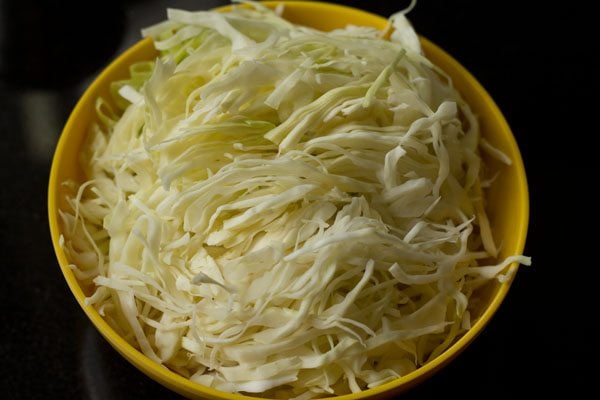
2. Heat 2.5 tablespoons of oil in a shallow pan or kadai. You can use any neutral-flavored oil.
Then add ½ teaspoon of cumin seeds and let them splutter on low heat.
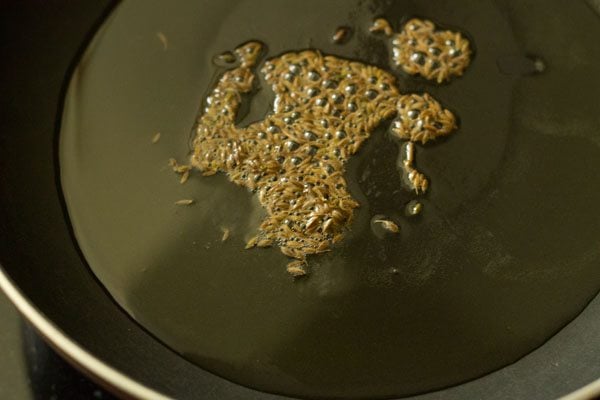
3. Next add 12 to 15 curry leaves, 1 green chili (chopped) and a pinch of asafoetida (hing). Stir and mix well.
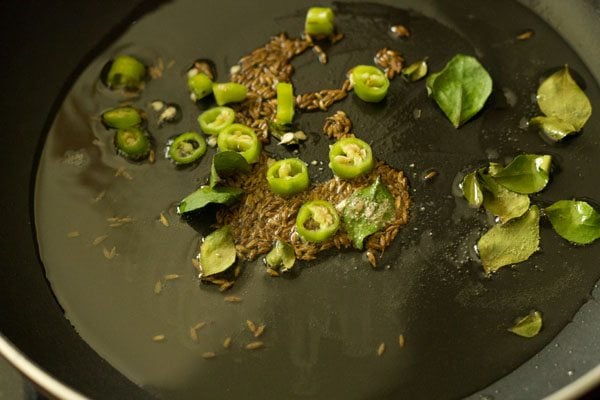
4. Now add the shredded or chopped cabbage.
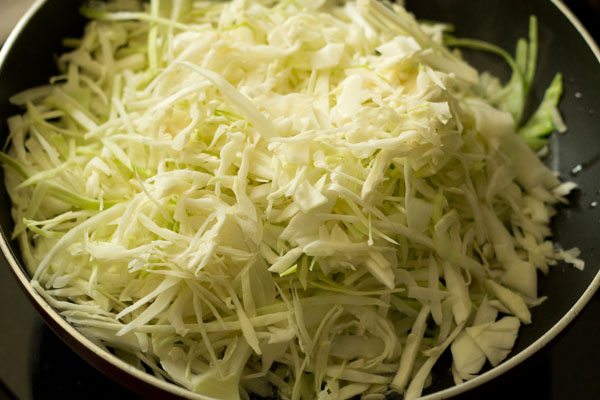
5. Season with salt as per taste.
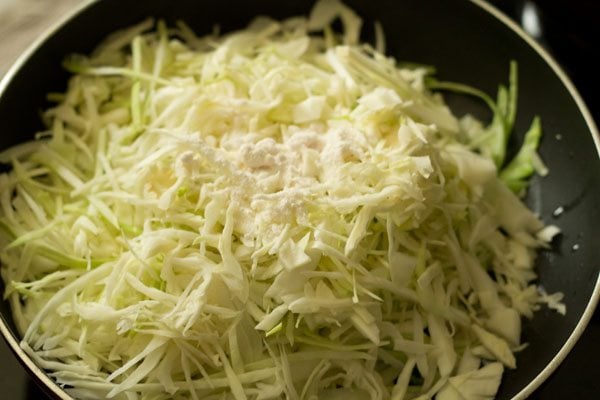
6. Mix the salt very well with the cabbage.
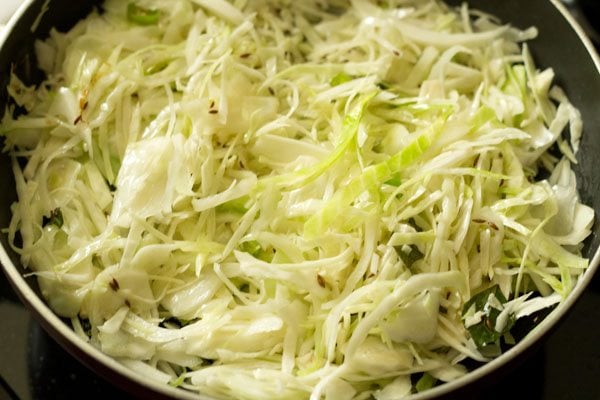
7. Keep a rimmed lid on top of the pan. Pour water on the lid. The water in the lid, creates steam in the pan and helps in cooking the cabbage. Cook the cabbage on a sim or a low heat.
Alternatively, you can add some water (about ¼ to ⅓ cup) in the pan. Cover with a lid and cook the cabbage. If the water dries up whilst cooking and the cabbage is not cooked, then you can add some more water. In case the water dries.
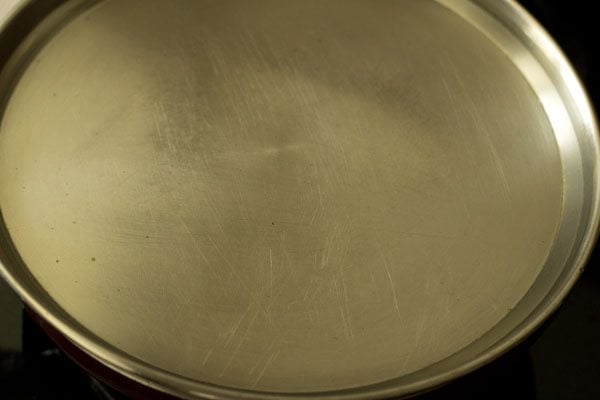
8. Do check the cabbage after every 5 to 6 minutes, by carefully removing the lid. In case the water dries on the lid, then add some more water and continue cooking the cabbage.
If you see the cabbage getting browned, then sprinkle some water in the pan. Usually, the cabbage does not get browned. But depending on the type and quality of the pan, the cabbage can get browned.
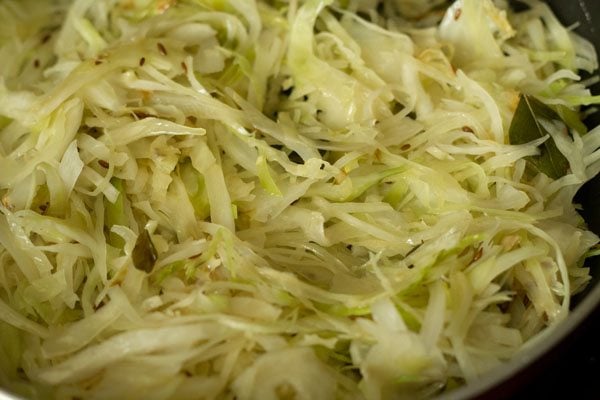
9. On a low heat, steam till the cabbage is softened and cooked well.
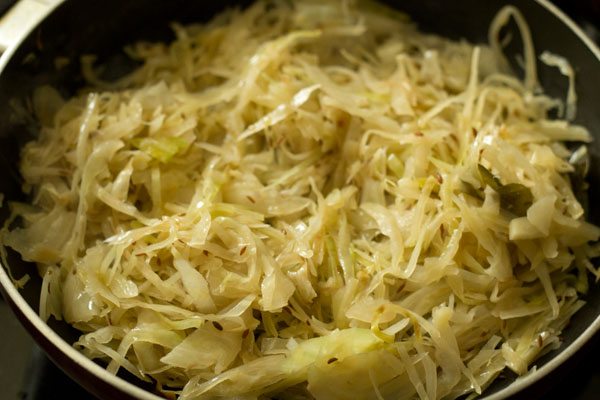
10. When done, then add ¼ cup grated coconut. The cabbage bhaji should be dry when you add coconut. Instead of grated coconut, you can also add ¼ cup of desiccated coconut powder.
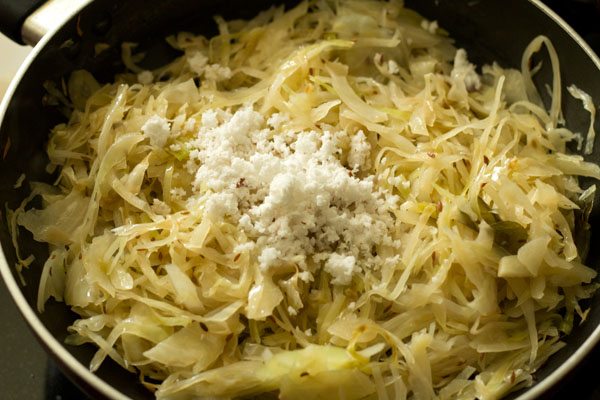
11. Mix well and saute for a minute.
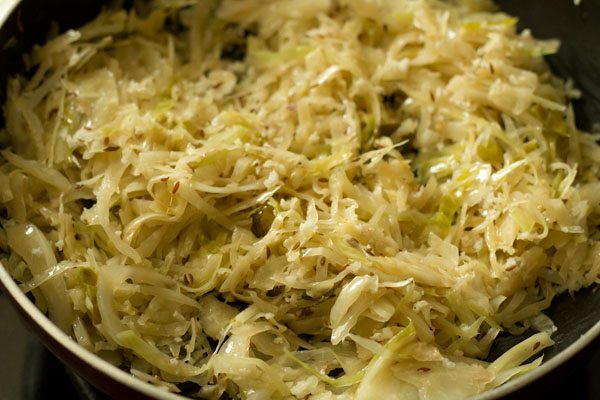
12. Switch off the heat. Lastly, add 2 tablespoons of chopped coriander leaves. Again stir and mix.
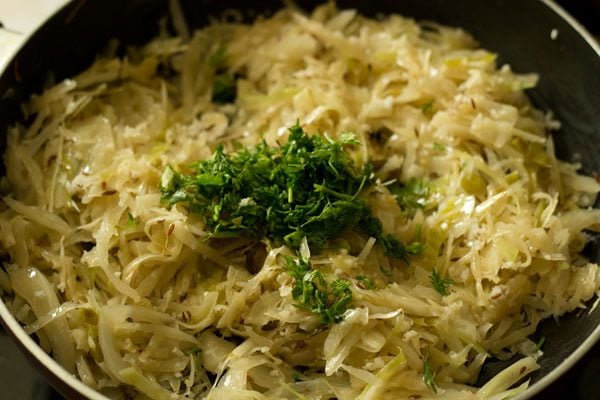
12. Serve cabbage bhaji hot or warm with chapatis or paratha or as a side dish with any dal-rice or sambar-rice.
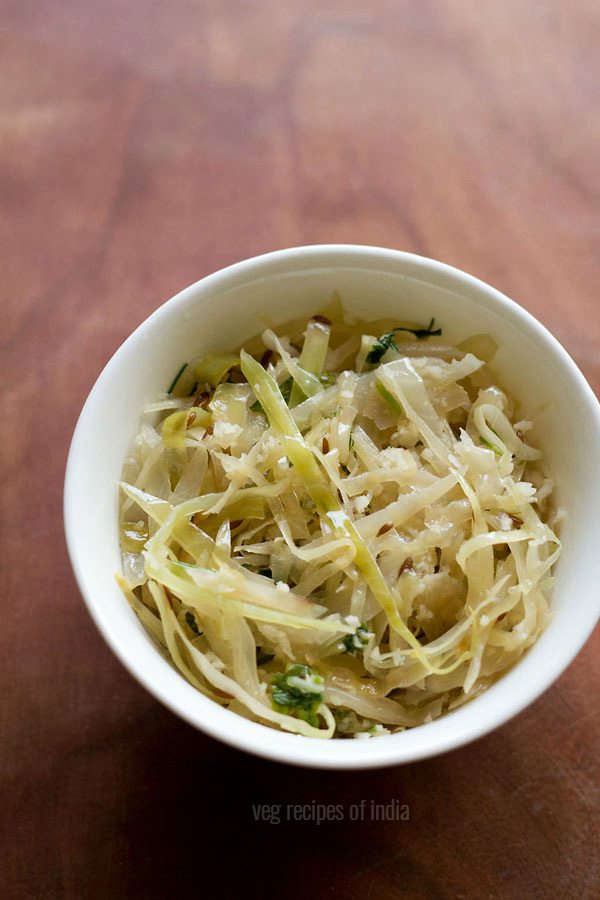
Few more tasty and healthy vegetable recipes you may like:
Please be sure to rate the recipe in the recipe card or leave a comment below if you have made it. For more vegetarian inspirations, Sign Up for my emails or follow me on Instagram, Youtube, Facebook, Pinterest or Twitter.
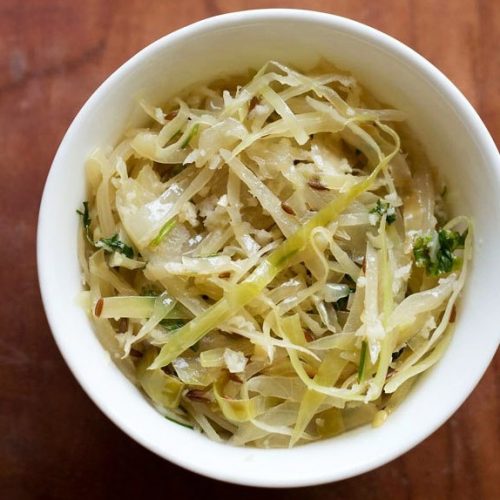
Cabbage Bhaji
Ingredients
- 2.5 tablespoons oil
- ½ teaspoon cumin seeds
- 12 to 15 curry leaves
- 1 green chili, chopped
- 1 pinch asafoetida (hing)
- 4 cups chopped cabbage (patta gobi) or 300 grams cabbage – shredded or chopped
- salt as required
- ¼ cup tightly packed grated coconut or desiccated coconut powder
- 2 tablespoons chopped coriander leaves
Instructions
- Rinse and then slice or shred or chop 300 grams cabbage. Also chop 1 green chili. Keep aside.
- Heat oil in a shallow kadai or a shallow frying pan.
- Add cumin seeds and let them splutter.
- Then add curry leaves, chopped green chilies and a pinch of asafoetida. Stir and mix well.
- Cover the pan with a rimmed lid. Pour water on the lid. The water in the lid, creates steam in the pan and helps in cooking the cabbage. Steam cook on sim or a low flame.
- Do check the cabbage after every 5 to 6 minutes, by carefully removing the lid. In case the water dries on the lid, then add some more water and continue cooking the cabbage.
- If you see the cabbage getting browned, then sprinkle some water in the pan. Usually the cabbage does not get browned. But depending on the type and quality of pan, the cabbage can get browned.
- When the cabbage is cooked well, then add 1/4 cup grated coconut. Mix well and saute for a minute.
- Switch off the heat. Lastly add 2 tablespoon chopped coriander leaves. Mix well.
- Serve cabbage bhaji hot with chapatis or paratha a side dish with any dal-rice or sambar-rice.
Notes
- Instead of asafoetida, 3 to 4 medium garlic cloves can be used.
- This recipe can be easily scaled to make a bigger or smaller batch.
- To make the dish gluten-free skip adding asafoetida or source gluten-free asafoetida.
Nutrition Info (Approximate Values)
This Cabbage Bhaji post from the blog archives first published in July 2016 has been updated and republished on December 2022.
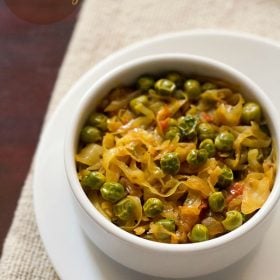
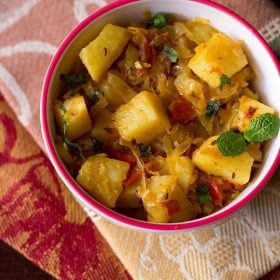
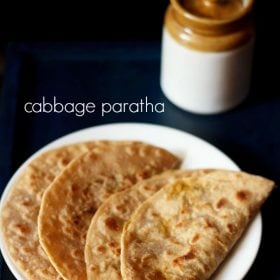
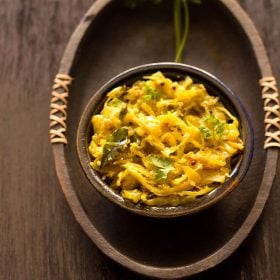








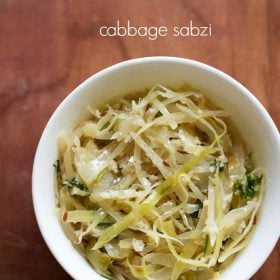
I have cooked using some of these recipes, and they are so delicious! Thank you for creating this site.
glad to know this thank you asma 🙂 and you are welcome.
Such a nice recipe !!
This is one of my favorite and and being Gujarati we’re cooking this recipe more often.
It would be delicious if you add shredded carrot & spring onion along with cabbage.
Please do try and you’ll amazed.
thankyou vimal will try your suggestion 🙂
hi,
your recipes are awesome, i have tried many of these and those are made really very good as per your instructions. please add some soyabin recipes please
thankyou sandeepa, which soyabean recipe are you looking for?
soyabin chunks
sandeepta, i do not use soy bean chunks. i had read an article some years back as to the manufacturing of soy bean chunks in india, which stated that these are not good for health. after that i stopped using soy bean chunks and granules. i am not able to get the article or else i would have shared the it with you.
okay, thank you.
welcome sandeepta.